Landmark itself has been in Spitalfields since 2004, when we received Peter Lerwill's most generous legacy of his house at 13, Princelet Street. Spitalfields holds an astonishing array of architecture dating from the early 18th century onwards, and at the heart of this lies the former Black Eagle Brewery, later the Truman Brewery.
When the brewery was founded, there was little development beyond the City walls that ran along today’s Bishopsgate. The c 1561 map of London attributed to Ralph Agas shows an area of fields and market gardens grouped around 'the Spittel Fyeld' that gave the area its name, after the nearby 'hospital' or monastery. Click here to see the whole interactive map.
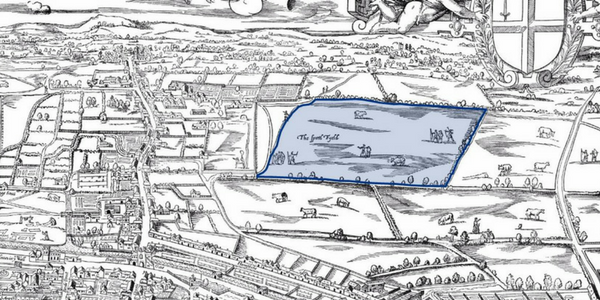
Around 1600, Spitalfields was still a rural area of fields and market gardens as shown in Agas’s map of c. 1561.
All this started to change, almost as soon as Agas had drawn his map. In 1572 the St Bartholomew Day's massacre took place in Paris, the start of a campaign of persistent persecution of Protestants (or Huguenots as they were known) across France. Many were hard working, skilled artisans in luxury goods like clocks, silk weaving and silverware; Elizabeth I 's Protestant regime in Britain offered an obvious refuge. Banned by the City Guilds from trading within the city walls, areas like Spitalfields just beyond were ideal places to start their new lives.
Then in 1666 domestic disaster struck, with the Great Fire of London. Now not only immigrants but Londoners needed new homes. Over the next decades, a frenzy of speculative house building took hold, swallowing up the market gardens and tenter grounds where cloth was spread to dry. Princelet (or then Prince's) Street is entirely typical of this phase. It was built by 1720, its houses speculative projects for masons or carpenters who leased a plot and erected a building in anticipation of profit.
As a malodorous undertaking, brewing was traditionally done downwind of the City. The first Truman on Brick Lane is noted in 1666, when Joseph Truman joined William Bucknall’s Brewhouse on Brick Lane and Eagle Street. When Bucknall died in 1679, Truman acquired the lease of this messuage, brewhouse, granary and stable and the business started to grow.
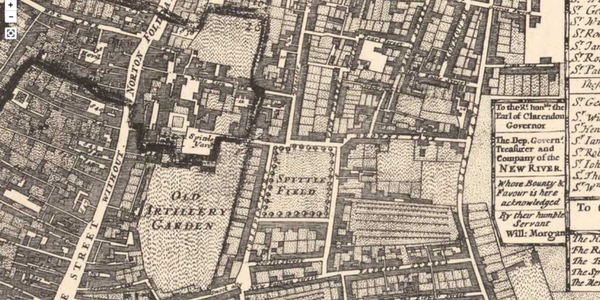
By Morgan & Ogilby’s map of 1682, the Spittle Field has been almost swallowed up by surrounding development. Black Eagle Street, site of the brewery, is one block north of Brown’s Lane. The smallholdings south of Brown’s Lane will soon become Prince’s and Fournier Street, and Hawksmoor’s Christ Church. Click here to see the whole map.
Under his son Benjamin Truman, who joined the family firm in 1722, the brewery holdings grew considerably and spanned both sides of Brick Lane. By 1748, The Black Eagle Brewery was the third largest in London, producing 40,000 barrels each year.
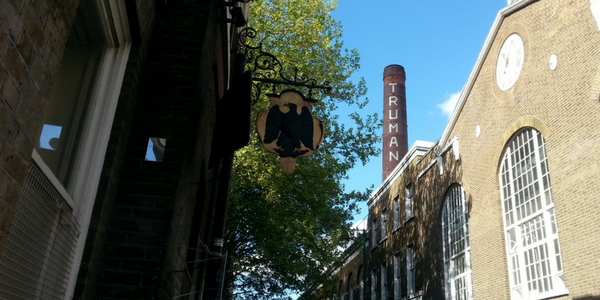 The Black Eagle sign still hangs from the Director’s House on the corner of Hanbury Street and Brick Lane, marking the original heart of this brewing empire.
The Black Eagle sign still hangs from the Director’s House on the corner of Hanbury Street and Brick Lane, marking the original heart of this brewing empire.
Many Huguenot immigrants were among the workforce, and they brought experience of fermented hops as a new ingredient, and different production techniques. This led the development of a well-hopped dark beer made with brown malt, called 'porter' and gave the brewery a competitive edge in the market.
In the 1720s, Benjamin Truman lived at 4, Princelet Street. As he walked the two blocks over to the brewery, he must have tipped his hat to his neighbour across the street, the tailor Edward Armorer who lived at No 13. He would also have known his neighbour at No. 3 Princelet Street, the talented silk designer Anna Maria Garthwaite. The heavy aroma of brewer's malt must have permanently hung over the district.
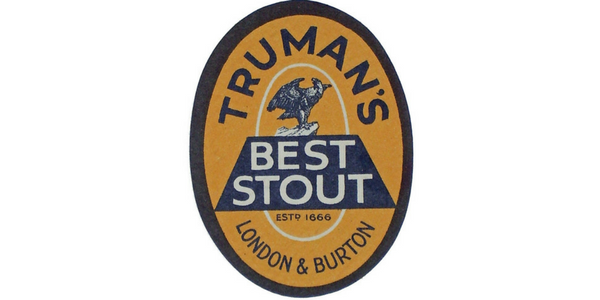
Vintage Truman’s label. In 1873 the company acquired a brewery (Phillips) in Burton-on-Trent and named the major new brewery after the original London site
Benjamin Truman oversaw the biggest development of the business and became a leading industrialist, knighted by George III on his accession in 1760 and painted by Gainsborough and Romney.
In 1789 the brewery was taken over by Sampson Hanbury and in 1816 became Truman, Hanbury, Buxton & Co. Through the 19th century the brewery premises became so extensive that they swallowed minor streets: Monmouth, George , Black Eagle Streets were all absorbed into the site. By 1853 the brewery was the largest in the world, producing 400,000 barrels of beer each year, with a site covering six acres. Charles Dickens knew it well: in David Copperfield, Mrs Micawber mentions Truman, Hanbury and Buxton as an example of the ‘e-NOR-mous’ profits to be made in brewing.
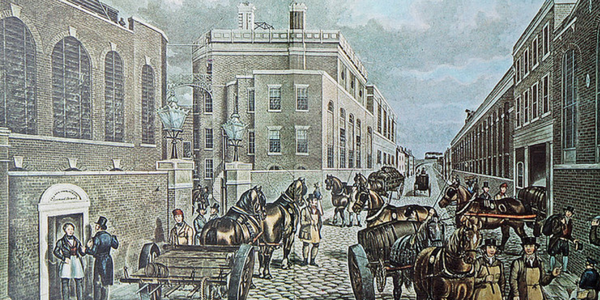 The Brick Lane brewery in 1842 as Dickens would have known it, and before the chimney was built in the 1940s. Note the lamps and wrought iron entrance arch, which still exist today.
The Brick Lane brewery in 1842 as Dickens would have known it, and before the chimney was built in the 1940s. Note the lamps and wrought iron entrance arch, which still exist today.
It was a fully integrated business: the east gateway on Spital Street still has 'Cooperage' carved on its lintel, indicating that here barrels were made and stored. And the barrels of beer then had to be delivered, and collected when empty, from pubs across the East End, on brewery wagons drawn by teams of hardworking drays. The horses were stabled in one of the largest blocks on the east side of Brick Lane, and the wagons loaded on Dray Walk.
Eventually the drays were replaced by motor vans. Production began to shift to a sister brewery in Burton-on-Trent, and in the mid-20th century, brewery fell victim to corporate merger and consolidation. In 1989, the bustling site fell quiet. In other parts of Britain, large industrial sites like this one can prove among the most intractable to revive: the Buildings at Risk registers have many such, and Landmark often reviews them to see if there is any way we can help, but our form of re-use by conversion for holidays is too specific for such large sites, their futures depending on massive commercial investment as well as vision.
In large cities at least, such a combination is more likely to emerge. While at least half the fully evolved Truman's site still awaits a new future (its walls meanwhile hosting some fine examples of street art), this historic Spitalfields site has reinvented itself once more. There is a large exhibition hall where the main brewing coppers once were. Each summer (and in 2017 coinciding with Inspiring Landmarks) art students hold their end of year exhibitions here under the umbrella title of Free Range.
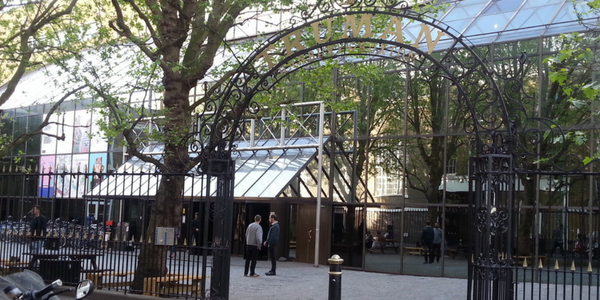 The old entrance to the Brewery today, with new exhibition space F block behind.
The old entrance to the Brewery today, with new exhibition space F block behind.
Plenty of beer still flows on Dray Walk, but now it's poured in lively bars. Former warehouses and storage areas have been transformed into short hire units like the one we have taken for Inspiring Landmarks, hosting interesting pop-up shops and exhibitions. Weekend markets are held on the part of the site across Brick Lane.
And there is even news of a quite different form of heritage restoration. When the brewery closed, samples of its brewer's yeast were frozen. In 2010, a team of young brewers revived the Truman name and started New Truman Brewery in Hackney Wick. The original yeast strain, ‘the beer’s soul’, preserved in liquid nitrogen at a temperature of -196 degrees C, has been revived. The centuries old cycle of East End brewing has begun all over again.
Today Spitalfields is a lively kaleidoscope of past and present. The Old Truman Brewery, revitalised and renewed, is a perfect foil for Landmark’s own work in saving historic buildings. A visit to Inspiring Landmarks also offers the perfect chance to explore this rich and fascinating area.